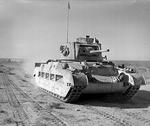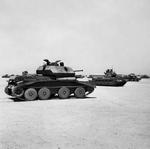Infantry Mk II Matilda
| Country | United Kingdom |
| Manufacturer | Vulcan Foundry, Newton-le-Willows, England, UK |
| Primary Role | Infantry Tank |
Contributor: C. Peter Chen
ww2dbaseInfantry Tank Mk II was a tank design named after a cartoon duck, "Matilda", a name shared with its Mk I predecessor design. The design was done at the Royal Arsenal at Woolwich near London, England, United Kingdom. The design improved upon the lightly-armed Mk I by dramatically increasing armor and adding a QF 2-pounder tank gun.
ww2dbaseWhen the design was complete, Matilda tanks were built at the Vulcan Foundry at Newton-le-Willows, Merseyside, England, starting in 1937, though only two were available for combat when the European War began in 1939. Compared to contemporary infantry tanks, the Matilda tanks were extremely slow largely due to their excessive weight, but this problem was considered a non-issue as British armor doctrine for infantry tanks required them to be only as fast as the speed of infantry. They were first seen in combat by the 4th and 7th Royal Tank Regiments in France in 1940 with great combat records as their thick armor were nearly invulnerable in the face of German tank guns, forcing the Germans to use the 88-mm anti-aircraft guns in anti-tank role to counter the Matilda tanks. In North Africa, their armor enjoyed a similar advantage against Italian forces, but their speed caused to be rather useless at certain situations in the open desert. With the arrival of German forces in North Africa, effective anti-tank guns and modern tanks made Matilda tanks obsolete. Slowly replaced by Valentine and Lee/Grant tanks, production of Matilda tanks ceased in 1943.
ww2dbaseIn North Africa, Germans captured a small number Matilda tanks at various engagements and pressed them into service. Despite prominent German markings, their presence in battles often confused tank commanders on both sides. The Germans naturally did not believe the Matilda tanks to be on par with tanks in their own arsenal, but generally welcomed the addition of the heavy armor to cover infantry movements.
ww2dbaseThe Russian forces also fielded 1,084 Matilda tanks. They were first put in use during the Battle of Moscow in the winter of 1941-1942. They were used throughout the entire European War, though they generally received average to poor reviews from their Russian crews. Reports of snow and mud clogging up suspension systems were the most frequent complaint.
ww2dbaseThe Australian 4th Armored Brigaded operated Matilda tanks throughout the Pacific War. Against the lightly armored and lightly armed Japanese tanks, they were extremely effectively through the end of the war.
ww2dbaseBetween 1937 and 1943, Vulcan Foundry and other firms built 2,987 Matilda tanks.
ww2dbaseSource: Wikipedia.
Last Major Revision: Oct 2008
Infantry Mk II Matilda Timeline
| 18 jun 1940 | The British War Office placed an order for 300 Canal Defence Light (CDL) tanks, Matilda tanks mounting a large searchlight in the turret that had been suggested by a Mr. Mitzakis in September 1939. |
SPECIFICATIONS
Matilda
| Machinery | TWo AEC 6-cyl diesel engines or two Leyland 6-cyl diesel engines rated at 180hp total |
| Suspension | Horizontal coil spring |
| Armament | 1x40mm QF 2-pdr L/50 gun (93 rounds), 1x7.92mm BESA machine gun |
| Armor | 20-78mm |
| Crew | 4 |
| Length | 6.00 m |
| Width | 2.60 m |
| Height | 2.50 m |
| Weight | 27.0 t |
| Speed | 24 km/h |
| Range | 257 km |
Photographs
 |  |  |  |
Você gostou deste artigo ou achou este artigo útil? Se sim, considere nos apoiar no Patreon. Qualquer valor já vai ajudar! Obrigado. Por favor, ajude-nos a divulgar o site: Fique atualizado com WW2DB: |
Visitor Submitted Comments
All visitor submitted comments are opinions of those making the submissions and do not reflect views of WW2DB.

- » Wreck of Teruzuki Found (27 jul 2025)
- » USS Orlean's Bow Found (22 jul 2025)
- » The Emperor of Japan Planned to Honor WW2-era Japanese POWs in Mongolia (4 jul 2025)
- » US State Lawmaker John Winter Caught Using Racial Slur "Jap" and Apologized (11 jun 2025)
- » US Government Plans to Purge WW2 Information (17 mar 2025)
- » Ver todas as notícias
 |
- » 1,181 biografias
- » 337 eventos
- » 45,111 entradas na linha do tempo
- » 1,246 navios
- » 350 modelos de aeronaves
- » 207 modelos de veículos
- » 376 modelos de armas
- » 123 documentos históricos
- » 261 instalações
- » 470 eventos
- » 28,473 fotos
- » 365 mapas
Winston Churchill, 1935
Por favor, considere nos apoiar no Patreon. Mesmo R$1 por mês já faz uma grande diferença. Obrigado!
Ou, por favor, nos apoie adquirindo alguns produtos do WW2DB na TeeSpring. Obrigado!
21 Jul 2009 01:08:59 AM
"They were first seen in combat by the 4th and 7th Royal Tank Regiments in France in 1940 with great combat records as their thick armor were nearly invulnerable in the face of German tank guns, forcing the Germans to use the 88-mm anti-aircraft guns in anti-tank role to counter the Matilda tanks." ..... In fact there were just sixteen Matilda IIs with the 1st Army Tank Brigade during the battle (Arras, 1940). The bulk of the two Regiments involved were made up of machine-gun armed Matilda Is witb Vickers Lights as command tanks.